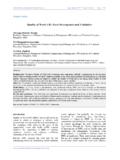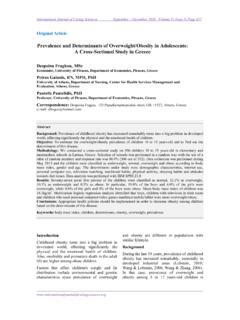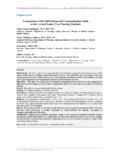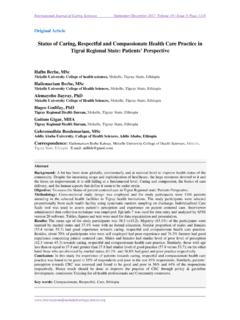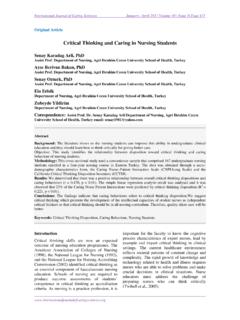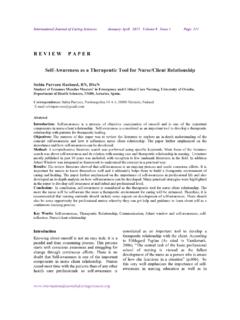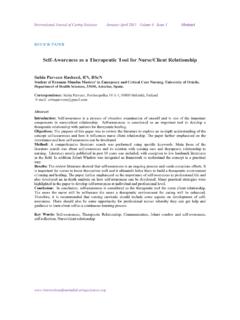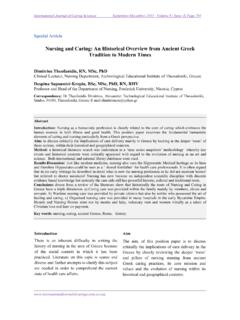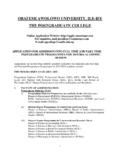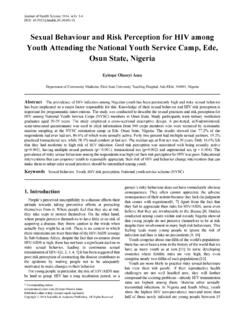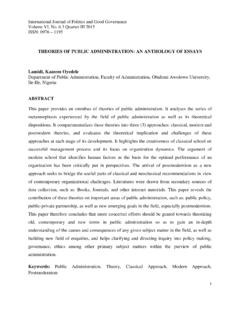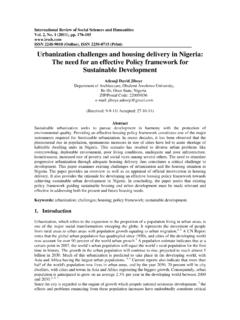Transcription of . O R I G I N A L P A P E R .r . Partograph Utilization …
1 International Journal of Caring Sciences May-August 2014 Vol 7 Issue 2 678 . O R I G I N A L P A P E R .r . Partograph Utilization at Three Levels of Health Care Delivery Services in Ile-Ife, Nigeria Ogunfowokan Adesola, FWACN, RN, PhD Senior Lecturer, Department of Nursing Science, Faculty of Basic Medical Sciences, College of Health Sciences, Obafemi Awolowo University, Ile-Ife, Osun-State,Nigeria, West Africa Irinoye Omolola, RN, PhD Associate Professor, Department of Nursing Science, Faculty of Basic Medical Sciences, College of Health Sciences, Obafemi Awolowo University, Ile-Ife, Osun-State,Nigeria, West Africa Olowokere Adekemi, RN, MScN Lecturer, Department of Nursing Science.
2 Faculty of Basic Medical Sciences, College of Health Sciences, Obafemi Awolowo University, Ile-Ife, Osun-State,Nigeria, West Africa Onipe Audu, RN, BNSc Clinical Nurse Federal Medical Centre, Owo, Ondo State, Nigeria, West Africa Correspondence: Ogunfowokan Adesola A. Department of Nursing Science, Faculty of Basic Medical Sciences, College of Health Sciences, Obafemi Awolowo University, Ile-Ife, Osun-State, Nigeria, West Africa. E-mail: Abstract Background: The Partograph is considered a valuable tool in the improvement of maternity care that allows for prompt identification of problems of labour but, disparities in its usage across health care facilities have been documented.
3 Objectives: The study was designed to identify the extent of use of Partograph by obstetric staff, assess for correct Partograph charting on case files of delivered mothers, and identify factors influencing the use of Partograph Methods: A retrospective design was adopted. Thirty-two health personnel comprising 22 midwives, 5 maternity unit leaders, and 5 community health extension workers (CHEWs) participated in the study, while 304 case files were examined for appropriate Partograph charting. Data was also collected using questionnaire, interview schedule, and observation checklist. Data analysis was by descriptive and inferential statistical methods.
4 Results: Findings showed that only and of the 304 case files assessed had correct graphical charting of moulding and blood pressure respectively. Interview results showed that Partograph charts were not being used at the primary and secondary health care maternity units. Absence of Partograph charts (14%), and inadequate knowledge of obstetric staff (14%) were reported as factors militating against the use of the Partograph . Conclusion: The use of the Partograph by obstetric staff is still at a low ebb in primary, secondary and tertiary health care institutions. Key words: Attitude, Knowledge, Awareness, Partograph charting.
5 International Journal of Caring Sciences May-August 2014 Vol 7 Issue 2 679 Background The outcome of any pregnancy is dependent largely, among other causes, on intrapartum care. Poor intrapartum care remains the major cause of maternal morbidity and mortality worldwide (Fawole, et al. 2008). Every year, 536,000 women and girls die as a result of complications during pregnancy, childbirth or peuperium and this amount to one death of every woman, every minute of every day (United Nations, 2009). Dzadeyson (2007) reported that more than half of women who die every year from pregnancy-related causes are in the African region, which constitutes only 12% of the world's population and 17% of its births.
6 It has also been estimated that 287,000 maternal deaths occurred worldwide in the year 2010 and 85% of this estimate occurred in Sub-Saharan Africa and Southern Asia (WHO, UNICEF, UNFPA and the World Bank, 2012). The 2008 Nigeria Demographic and Health Survey estimated the overall maternal mortality ratio (MMR) at 545:100,000 live births with wide variation across the geographical zones in the country (Bologoi, 2011). Since 1987, global efforts have been focused on reducing maternal and neonatal mortality and morbidity associated with intrapartum care most especially in the developing countries.
7 Many programs and tools have been developed to monitor and manage women in labour, one of which is the use of the Partograph that was developed by Philpott in 1971 and was later modified by the World Health Organization (Mathibe-Neke et al, 2013). The Partograph is considered a valuable tool in the improvement of maternity care that allows trained health personnel to record intrapartum details graphically such that, problems of labour are identified early for prompt intervention (World Health Organization, 2003). Studies have shown that, using the Partograph can be highly effective in reducing complications from prolonged labour for the mother (postpartum hemorrhage, sepsis, uterine rupture and its sequelae) and for the newborn (death, asphyxia, infections, etc.)
8 (Fawole et al, 2010; Oladapo et al, 2006). Implementation of the Partograph also implies a functioning referral system with essential obstetric functions in place which will improve the efficiency and effectiveness of maternity services. Aside from the fact that the Partograph is an effective tool for monitoring labour, Walsh (2004) have documented that it could constitute a legal document and also an avenue for identifying accountability in midwifery practice. As a result of the belief that Partograph usage was applicable in both the developed and developing settings to detect abnormal labour and monitor labour to a successful second stage, its use was then introduced worldwide by the World Health Organization (Lavender, 2006).
9 Despite the long introduction of the Partograph to the health care industry and wide documentation of its effectiveness (Fahdhy and Chongsuvivatwong, 2005; Fawole and Fadare, 2008), some researchers in Nigeria have documented disparities in usage across health care facilities in Nigeria. In a study conducted by Opiah (2001) in two Nigerian tertiary health care institutions, findings revealed that majority of the midwives (84%) in the study had good knowledge of the Partograph but an average of Partograph charts were properly filled. According to Opiah, some hindering factors to effective Utilization of Partograph included non-availability of Partograph charts ( ), and shortage of staff ( ).
10 The studies of Fawole, et al., 2010 and Oladapo, , 2006 among different categories of maternity care providers across three levels of health care revealed poor knowledge and poor usage of the Partograph . They also reported that prior training significantly influenced knowledge of the Partograph (gamma2 = ; p < ). Fawole, et al. 2010 and Oladapo, , 2006 further reported that Partograph was used frequently by health workers in tertiary level compared with health workers from primary and secondary levels of care. In addition, the studies of Fawole & Fadare, 2007, 2008 showed that only of 1, 319 deliveries had partographic monitoring, and that the use of the Partograph significantly influenced decision-making, and is associated with positive labour outcome among low and high-risk parturient.
